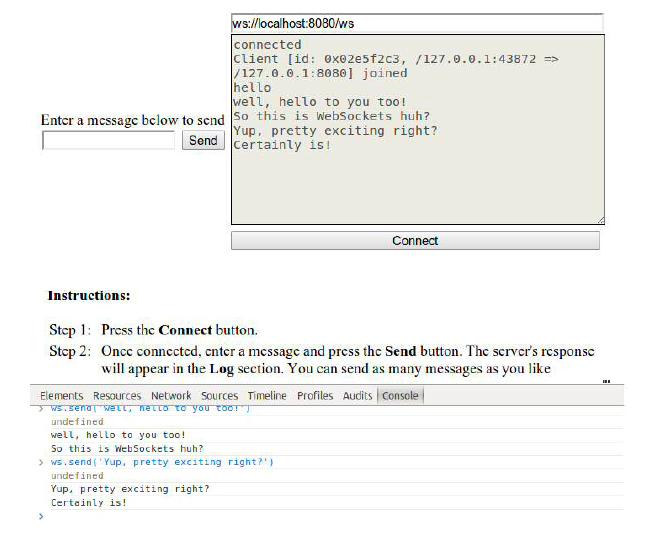Netty测试程序
使用下面命令启动服务器:
mvn -PChatServer clean package exec:exec
其中项目中的 pom.xml 是配置了 9999 端口。你也可以通过下面的方法修改属性
mvn -PChatServer -Dport=1111 clean package exec:exec
下面是控制台的主要输出(删除了部分行)
Listing 11.5 Compile and start the ChatServer
[INFO] Scanning for projects...
[INFO]
[INFO] ------------------------------------------------------------------------
[INFO] Building ChatServer 1.0-SNAPSHOT
[INFO] ------------------------------------------------------------------------
...
[INFO]
[INFO] --- maven-jar-plugin:2.4:jar (default-jar) @ netty-in-action ---
[INFO] Building jar: D:/netty-in-action/chapter11/target/chat-server-1.0-SNAPSHOT.jar
[INFO]
[INFO] --- exec-maven-plugin:1.2.1:exec (default-cli) @ chat-server ---
Starting ChatServer on port 9999
可以在浏览器中通过 http://localhost:9999 地址访问程序。图11.5展示了此程序在Chrome浏览器下的用户界面。
Figure 11.5 WebSockets ChatServer demonstration

图中显示了两个已经连接了的客户端。第一个客户端是通过上面的图形界面连接的,第二个是通过Chrome浏览器底部的命令行连接的。 你可以注意到,这两个客户端都在发送消息,每条消息都会显示在两个客户端上。
如何加密?
在实际场景中,加密是必不可少的。在Netty中实现加密并不麻烦,你只需要向 ChannelPipeline 中添加 SslHandler ,然后配置一下即可。如下:
Listing 11.6 Add encryption to the ChannelPipeline
public class SecureChatServerIntializer extends ChatServerInitializer { //1
private final SslContext context;
public SecureChatServerIntializer(ChannelGroup group, SslContext context) {
super(group);
this.context = context;
}
@Override
protected void initChannel(Channel ch) throws Exception {
super.initChannel(ch);
SSLEngine engine = context.newEngine(ch.alloc());
engine.setUseClientMode(false);
ch.pipeline().addFirst(new SslHandler(engine)); //2
}
}
1.扩展 ChatServerInitializer 来实现加密
2.向 ChannelPipeline 中添加SslHandler
最后修改 ChatServer,使用 SecureChatServerInitializer 并传入 SSLContext
Listing 11.7 Add encryption to the ChatServer
public class SecureChatServer extends ChatServer {//1
private final SslContext context;
public SecureChatServer(SslContext context) {
this.context = context;
}
@Override
protected ChannelInitializer<Channel> createInitializer(ChannelGroup group) {
return new SecureChatServerIntializer(group, context); //2
}
public static void main(String[] args) throws Exception{
if (args.length != 1) {
System.err.println("Please give port as argument");
System.exit(1);
}
int port = Integer.parseInt(args[0]);
SelfSignedCertificate cert = new SelfSignedCertificate();
SslContext context = SslContext.newServerContext(cert.certificate(), cert.privateKey());
final SecureChatServer endpoint = new SecureChatServer(context);
ChannelFuture future = endpoint.start(new InetSocketAddress(port));
Runtime.getRuntime().addShutdownHook(new Thread() {
@Override
public void run() {
endpoint.destroy();
}
});
future.channel().closeFuture().syncUninterruptibly();
}
}
1.扩展 ChatServer
2.返回先前创建的 SecureChatServerInitializer 来启用加密
这样,就在所有的通信中使用了 SSL/TLS 加密。和前面一样,你可以使用Maven拉取应用需要的所有依赖,并启动它,如下所示。
Listing 11.8 Start the SecureChatServer
$ mvn -PSecureChatServer clean package exec:exec
[INFO] Scanning for projects...
[INFO]
[INFO] ------------------------------------------------------------------------
[INFO] Building ChatServer 1.0-SNAPSHOT
[INFO] ------------------------------------------------------------------------
...
[INFO]
[INFO] --- maven-jar-plugin:2.4:jar (default-jar) @ netty-in-action ---
[INFO] Building jar: D:/netty-in-action/chapter11/target/chat-server-1.0-SNAPSHOT.jar
[INFO]
[INFO] --- exec-maven-plugin:1.2.1:exec (default-cli) @ chat-server ---
Starting SecureChatServer on port 9999
现在你可以通过 HTTPS 地址: https://localhost:9999 来访问SecureChatServer 了。

 免费 AI IDE
免费 AI IDE



更多建议: